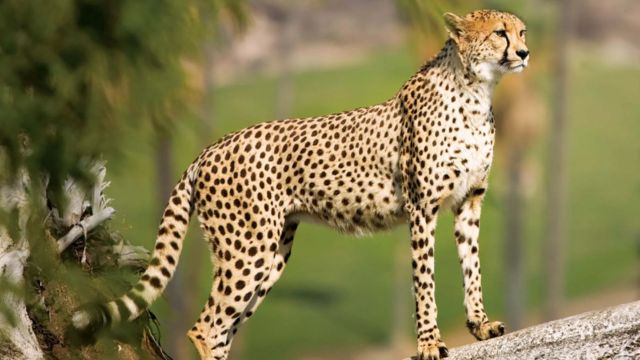Climate change, a significant worldwide concern, affects both people and animal species. Rising temperatures, melting ice caps, and shifting weather patterns are all significantly impacting the habitats of several species. The impact is far-reaching and deep, affecting everything from polar bears in the Arctic contending with melting ice to coral reefs bleaching as ocean temperatures rise.
Climate change has an impact on many animal species, including polar bears, penguins, sea turtles, walruses, and coral reefs. The article looks into the current situation of these species, highlighting how climate change is endangering their existence and changing biodiversity.
1. Cheetah
- Scientific Name: Acinonyx jubatus
- Habitat: Savannahs, arid mountains
- Range: Africa, Asia
- Vulnerabilities: Habitat loss, hunting, climate change, low sperm count
- IUCN Red List Status: Vulnerable
Cheetahs are members of the feline family Felidae, which is related to the domestic cat. It may be found in Africa and central Iran, living on savannahs and highlands. The cheetah is the world’s fastest land mammal, but it is on the verge of extinction.

The IUCN Red List classifies this wild cat as fragile, and one of the reasons is climate change. This not only contributes to habitat loss, which is a major issue, but it also has an impact on the cheetah’s primary prey.
With no alternative options, they are compelled to hunt other species with lower nutritional value. This reduces the sperm count. Temperature also influences the male cheetah’s sperm count and testosterone level, influencing its reproductive ability. You don’t have to be an animal specialist to recognize the hazards of this.
2. Jaguar
- Scientific Name: Panthera Onca
- Habitat: Forests
- Range: The Americas
- Vulnerabilities: Hunting, natural disasters, habitat loss
- IUCN Red List Status: Near Threatened
The jaguar is likewise a feline but from a different genus. It is the only Panthera creature endemic to the Americas; the rest of the Panthera genus is found in Africa or Asia.

The jaguar occupies a variety of ecosystems, including deciduous, rainforest, and cloud forests. The IUCN Red List classifies jaguars as near endangered owing to the risks they face.
Climate change causes natural disasters like storms and droughts, which have an impact on the jaguar population over time.
3. Adelie Penguin
- Scientific Name: Pygoscelis adeliae
- Habitat: Rocky beaches
- Range: Antarctica
- Vulnerabilities: Loss of ice
- IUCN Red List Status: Least Concern
Adelie penguins are members of the Spheniscidae family, which is the term given to the penguin family. It dwells in Antarctica, primarily on stony beaches.

It is the most widespread penguin, yet its range is restricted to Antarctica. It is also one of the few penguin species that nest on the continent. The Adelie penguin is classed as least concern, which means it is currently not under threat of extinction. However, climate change affects this bird.
As temperatures increase, ice melts, reducing the availability of krill, the Adelie penguin’s favored meal. With no other choice, the Adelie penguin is compelled to move in search of food, which disrupts its breeding process.
4. Asian Elephant
- Scientific Name: Elephas maximus
- Habitat: Grasslands, evergreen forests, deciduous forest
- Range: Asia
- Vulnerabilities: Habitat loss, fragmentation
- IUCN Red List Status: Endangered
The Asian elephant, often known as the Asiatic elephant, is the sole species in the genus Elephas. It is found across Asia, including India, Nepal, Borneo, and Sumatra. The Asian elephant used to have five subspecies, but now only three remain because the other two have been extinct.

The IUCN Red List now lists this species as endangered, with climate change being one of several contributing factors. The high temperature causes water shortages, which is harmful for elephants because they require a lot of water. It can also alter their diet by causing other plants to grow beyond what the elephant is used to eating.
5. Green Turtle
- Scientific Name: Chelonia mydas
- Habitat: Bays, lagoons, shoals
- Range: Atlantic, Pacific, Indian Oceans, tropical and subtropical seas
- Vulnerabilities: Overharvesting of eggs, hunting, loss of nesting beach sites
- IUCN Red List Status: Endangered
The green turtle is sometimes referred to as the green sea turtle, Pacific green turtle, and black (sea) turtle. It belongs to the Cheloniidae family of big sea turtles, which includes six species.

The green turtle inhabits all three major oceans (Atlantic, Pacific, and Indian), as well as several tropical and subtropical waters. The green turtle is classed as Endangered on the IUCN Red List. Rising temperatures have an impact on sea turtle sex ratios because the temperature of the sand controls the sex of the developing eggs.
Warmer temperatures can increase the number of female turtles, affecting the species’ long-term health and survival. In addition to sex ratios, increasing sea levels and increased storm activity can damage nesting sites, making successful breeding more challenging.
Changes in water temperature and chemistry also alter sea turtles’ food sources, threatening their general health and survival.
Conclusion
Climate change poses a significant hazard to many animal species, disrupting their habitats and threatening their survival. Climate change necessitates urgent conservation efforts to protect biodiversity and ecosystems, from cheetahs at risk due to altered prey and reduced sperm count to jaguars facing natural disasters, Adelie penguins experiencing disrupted breeding, Asian elephants facing water shortages, and green turtles dealing with sex ratio imbalances and changing food sources.
